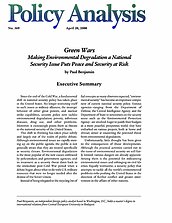Since the end of the Cold War, a fundamental shift in national security policy has taken place in the United States. No longer restricting itself to such issues as military alliances, the strategic behavior of other great powers, and nuclear strike capabilities, security policy now tackles environmental degradation, poverty, infectious diseases, drug use, and other problems. Moreover, it increasingly posits them as threats to the national security of the United States.
This shift in thinking has taken place subtly and largely out of the realm of public debate. Although environmental issues are rapidly moving up on the public agenda, the public is not generally aware that they are treated specifically as security threats. Environmental degradation is the most popular of the new causes embraced by policymakers and government agencies, and its treatment as a security threat dates back to the immediate post-Cold War period when a debate began about what to do with U.S. military resources that were no longer needed after the demise of the Soviet Union.
Instead of being relegated to the recycling bin of fad concepts as many observers expected, “environmental security” has become an important component of current national security policy. Various agencies–ranging from the Department of Defense, the Central Intelligence Agency, and the Department of State to newcomers on the security scene such as the Environmental Protection Agency–are involved. Eager to justify their budgets in a more peaceful, prosperous world, they have embarked on various projects, both at home and abroad, aimed at countering the perceived threat from environmental degradation.
Unfortunately, little thought has been given to the consequences of those developments. Although the practical activities carried out in the name of environmental security are still fairly limited, various dangers are already apparent. Among them is the potential for militarizing environmental issues and infringing on civil liberties. Equally worrisome, a security policy that attempts to tackle all the world’s environmental problems risks pushing the United States in the direction of further conflict and greater intervention in the affairs of other nations.
About the Author

This work is licensed under a Creative Commons Attribution-NonCommercial-ShareAlike 4.0 International License.
